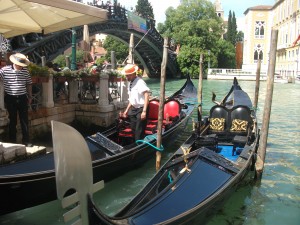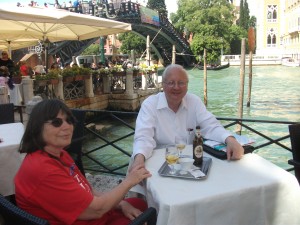Gondolas on the Canal Grande at the Accademia Bridge
If you are a veteran of Venice prone to sniff at the observations of a first-time visitor, this commentary may not be for you. I was invited to speak at a May 23 conference on climate change and cities at IUAV (Architectural University of Venice). I spent the next four days touring the city with my wife. I cannot pretend to be an expert, though I spent a modicum of time trying to absorb Italian, via Rosetta Stone, in the weeks preceding the trip. I also dived into a tour guide, plus Garry Wills’s book, Venice: Lion City: The Religion of Empire, and other sources to begin to divine what brought this gorgeously remarkable city into being and what sustains it today. I have learned a great deal quickly, but I am well aware of how much more there is to learn. It was a pity to have to return home, but most of us cannot afford to stay indefinitely. Too many other commitments lay ahead to allow me the luxury. For me, Venice was a brief encounter that begs for more.
I will blog more than once about Venice because the subject deserves it. Let me start this time with some general observations.
First: I have visited a few countries, though not dozens. Venice is absolutely, objectively unique. The sheer density of high-quality artwork produced per capita in this city over the centuries is astounding. Nothing appears in Venetian paintings by accident. Throughout the medieval and Renaissance periods, this art was almost entirely religious in focus, yet, as Garry Wills observes, art and religion were in the service of empire. Venice claimed St. Mark as its patron; to ensure that the point was not missed that he belonged in the city, Venetian merchants in the eight century stole his remains from Alexandria, where he had died at the hands of a mob. In the Venetians’ view, they repatriated them to what is now the Basilica San Marco. The palace of the doge, the ruler of Venice, was located in the same piazza adjoining the basilica. No one was to miss the point. This relationship is just the tip of the iceberg. One could spend considerable time exploring the intricacies of Venetian politics in the days of the city-state’s independence. Whole books have endeavored to do so.
Second: But there is more. The unusual setting—a city built atop a lagoon—is directly attributable first to the attempt by people in the area to escape the marauding Lombards in the fifth and sixth centuries, and then to the uniquely defensible attributes of this floating city with a navy to rival any in its time. European cities on “terra ferma” built moats and walls to defend themselves. Venice had none of that, but it built around and between canals and water bodies in ways that made it nearly unapproachable by any enemy that did not want to engage that navy, which even for the Turks could prove an exhausting enterprise. It has now been more than two centuries since Venice was independent, but the city that remains lacks cars—there is no place for them—but allows people to move about on foot or in boats. Take a map. We strolled the many narrow streets and squares (campi), crossed numerous bridges across both the narrow canals and the Grand Canal, got lost a few times, found our way again, and took water buses (vaporetti) in the rain, but the experience was special enough to justify every little frustration and every wasted minute. In fact, no minute was wasted. Turn a corner, wander down a narrow alley, discover some more history. In how many cities can you say that?
Third: Of course, when you wish, you can stop. And rest. Or eat. Or watch the boats go by. Near the Rialto, having spent a morning finding small gifts for friends, we simply stopped at a ristorante at the edge of the Grand Canal, ate a lunch of two types of spaghetti far better than most we are used to, imbibed some red wine, all while sitting outside just five feet from the Grand Canal, in the shadow of the Rialto. It would be hard, if not impossible, to find such settings in other cities so easily. On another occasion, having wandered from the Gallerie Accademia to the Santa Maria della Salute church, built in 1631 after the plague had struck the city, we found our way back to the Accademia bridge to discover a small restaurant and bar in its shadow, sat down for a pair of beers, and watched others hop into a gondola for the expensive ride (80 euros for 40 minutes)—all on a day when the temperature hovered around 70° F. with a slight breeze off the water. I could have stayed there much longer. Despite the concerns about Venice’s eventual fate as a result of global warming and sea level rise, for now at least, the climate seems quite congenial, if sometimes damp.
This is not much of a start, I know. It is merely a teaser to a sampler. More will have to come in bite-size installments throughout the summer. But it is a tiny hint of the richness of a visit to Venice. I can only wish I had been in a position to make it last longer.
Jim Schwab

